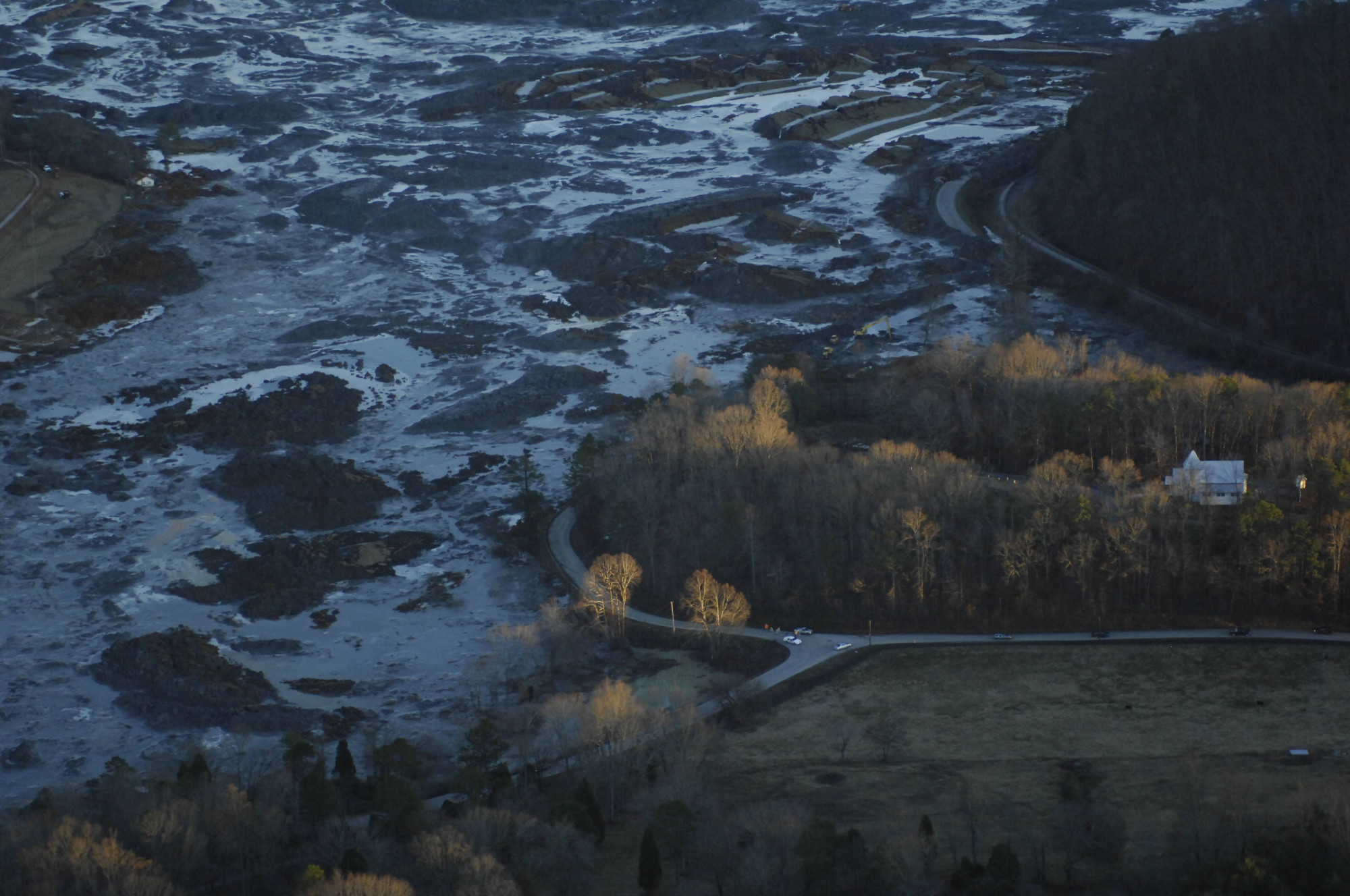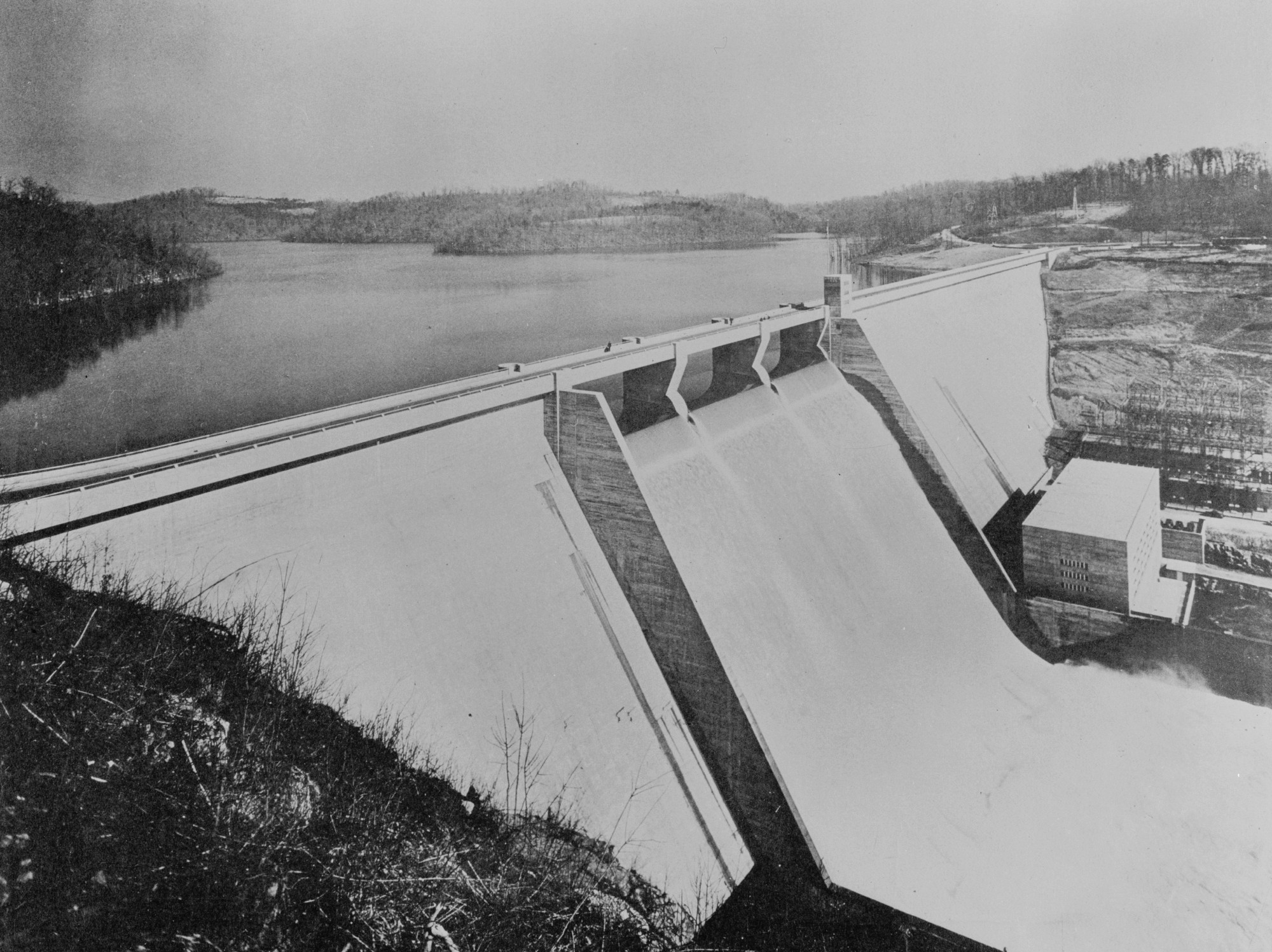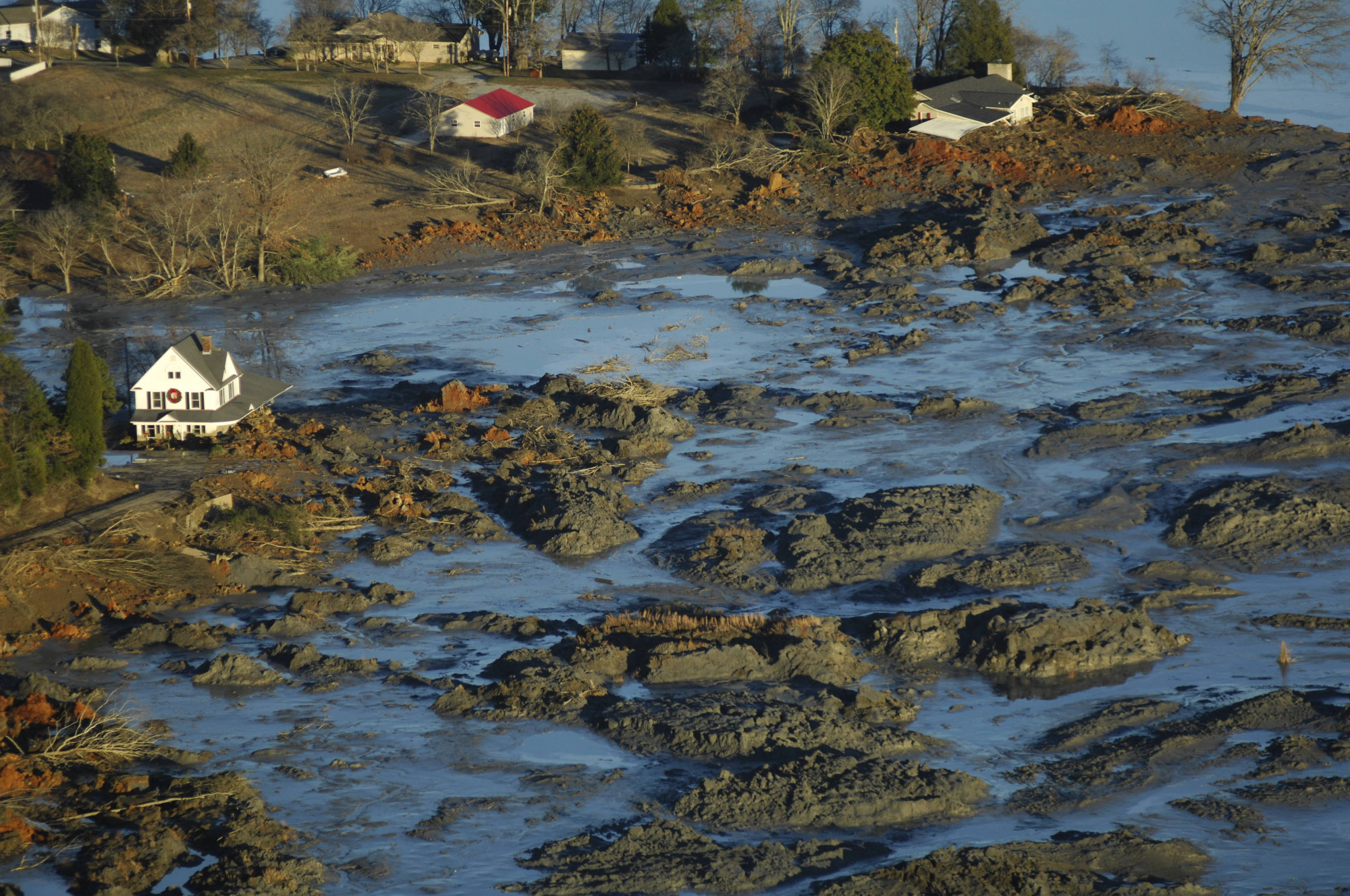
Courtesy of Appalachian Voices/Dot Griffith; flight courtesy of Southwings
The Toxic Wave That Swallowed a Tennessee Town
The night of the 2008 coal ash disaster in Kingston, Tennessee
By Jared Sullivan
An excerpt from Valley So Low: One Lawyer’s Fight for Justice in the Wake of America’s Great Coal Catastrophe, out now from Knopf.
On December 22, 2008, Ansol Clark woke to a ringing phone. It was sometime before 6 a.m., far earlier than he had intended to get up. He drove construction trucks for a living, but he’d been furloughed recently, leaving him little to do in the three days before Christmas except wrap gifts and watch movies with his grown son, Bergan. The house was dark. Janie, Ansol’s wife of thirty-six years, slipped out of bed, stepped across the bedroom, and disappeared through the doorway that led into the kitchen. A light clicked on, and the ringing stopped. She returned to the bedroom. “It’s for you,” she told Ansol.
In the kitchen, Ansol, groggy, picked up the landline from its place atop the bread box. You need to get up, a man told him, and you need to get up right away. Ansol recognized the caller’s voice: it belonged to his supervisor, a general foreman named Tim Henry. “Get to Kingston,” Henry added. “They’ve had a blowout down here.”
Ansol, needing no further explanation, hung up. Janie rushed to brew a thermos of coffee and wrap up biscuits while Ansol pulled on his work clothes: jeans, a blue down jacket, a neon hard hat, muck boots. At fifty-seven, he was a bull of a man, strong from hauling around equipment all day and from spending much of his free time hunting on the Cumberland Plateau; he liked to pick off squirrels with a .22 Magnum rifle. He, Janie, and Bergan lived in Knoxville, Tennessee, in a one-story brick home three miles from the farm where Ansol grew up. Within half an hour of receiving Henry’s call, he was pulling his Chevy S10 pickup truck out of the driveway and heading toward the Kingston Fossil Plant.
He made his way by headlights, following I-40 west out of town. He knew the route well. After a decade crisscrossing North America in a tractor-trailer, he’d joined the Teamsters labor union in 2000 and had spent much of the past five years working at the Kingston Fossil Plant, a coal-fired power station forty miles outside downtown Knoxville, in Roane County. Built and managed by the Tennessee Valley Authority (TVA), a giant federally-owned power company, the Kingston facility was, at the time of its completion in 1954, the world’s largest coal-fired power station. It burned fourteen thousand tons of coal a day, enough to fill one hundred and forty train cars and to power some seven hundred thousand homes.
With no traffic, Ansol reached the plant within thirty minutes. He met Henry in a parking lot; a few other Teamsters and some equipment operators showed up around the same time. In a shipping container used to store tools, the group waited for sunrise, anxious to see what they were up against. Ansol had something of an idea. Each day, the Kingston plant generated a thousand tons of coal ash, the sooty by-product of burning coal to produce electricity. Much of this ash ended up in an unlined pit in the ground, known as a holding pond. But Kingston’s “pond” was not really a pond, at least not anymore. In the 1950s, TVA started flushing coal ash into a spring-fed swimming hole, and, in the decades since, the ash had displaced the water and grown into a mountain, sixty feet tall, covering eighty-four acres, and situated at the confluence of two rivers, the Emory and the Clinch. It was a precarious setup, one made more so by the dike that contained all this ash—an earthen embankment made not of concrete or steel but of clay and bottom ash, a coarse, sandlike component of coal ash.
By that December morning in 2008, the ash mound had become a topographical feature so large that marathoners ran up it for training. TVA planted grass over it, so it resembled a hill, and bulldozers sculpted neat tiers into the sides, reminiscent of those of a stepped pyramid. But the mound lacked the sturdiness that its size suggested. Two years earlier, Ansol had helped to repair a minor breach in the dike that had sent coal ash rushing into a ditch. When he walked on the mound, the ground had jiggled like a water bed; when he drove his truck along the dike’s sloped sides, he went as slowly as possible, to avoid causing another rupture. He’d once told a coworker that the dike would surely fail one day. Now, it seemed, that day had come.
At first light, Ansol and Henry climbed into a pickup and drove up the back side of a large wooded bluff that overlooked the coal-ash mound. The sight at the top would stick in Ansol’s mind until the day he died.

Courtesy of Houston Cofield
Hours earlier, as the clock approached midnight, a stiff wind blew over the rolling countryside that surrounded the Kingston Fossil Plant. It was the winter solstice, and, in the quiet of that long night, the old farmhouses, country churches, trailer homes, and lakeside estates that dotted the hills and coves around the power station were dark and still. Christmas trees glowed in living rooms. The Year Without a Santa Claus played on TVs. Outside, the temperature hovered around 14 degrees Fahrenheit, cold enough to freeze the pipes at the McDonald’s in town.
Then, shortly before one o’clock, the north section of the coal-ash dike suddenly and almost wholly collapsed. When it did, more than a billion gallons of coal-ash slurry—about fifteen hundred times the volume of liquid that flows over Niagara Falls each second—broke forth. A black wave at least fifty feet high rushed northward with the power and violence of water punching through a dam.
A backwater inlet separated the coal-ash pond from a small peninsula along the Emory River. A few dozen homes sat along the water’s edge. As the black wave roared ahead, shaking the earth, it overwhelmed the inlet and slammed into the peninsula. Most of the slurry, nearly six million tons in all, forked right around the obstruction and rushed into the Emory River, filling in a forty-foot-deep channel. The rest of the ash, nearly three million tons, filled in two sloughs on either side of the peninsula, hurling fish forty feet onto the riverbank. The wave kept going. It downed trees, covered roads, and knocked out power lines. Docks were inundated; boats were carried away; soccer fields were smothered.
The wave first collided into the home of fifty-three-year-old James Schean. With a thundering boom, it ripped Schean’s vinyl-sided place off its foundation, upturning furniture, crushing door frames, and knocking over Christmas presents. The rafters cracked.
Down the road, Chris and DeAnna Copeland, a married couple with two young daughters, were awakened by the din. Chris, a firefighter, glanced out a window. A black torrent was flowing across his backyard in the moonlight. Trees bobbed in the muck. He got up and flipped a light switch. No power. In the dark, he pulled on a T-shirt and pants. Downstairs, he called 911 on his cell phone. There was a landslide, he said, or maybe something else. It was hard to tell. Then he hung up, grabbed a flashlight, and bolted outside.
Then, as now, the Kingston Fossil Plant had twin thousand-foot-high smokestacks that towered over the forested countryside. Far across the inlet that separated Copeland’s home from the plant property, he could see flashers blinking, as always, at the top of the two stacks, but there was no other light beyond that of the moon. He swept the ground with his flashlight. Debris and mud everywhere. A musty smell. Then he realized: it wasn’t mud; the coal-ash dike had failed. He owned a white Suzuki Sidekick. He climbed in, cranked the engine, drove into the backyard, and pointed the high beams toward the plant. A sea of coal ash had inundated the inlet. The black wave had dissipated within a minute, but smaller slides would continue for an hour or more.
Copeland’s next-door neighbor, Jeff Spurgeon, soon emerged from his home carrying a flashlight. The two men had known each other for years. The ash had washed within feet of their homes, but somehow it hadn’t touched either. Copeland jumped out of his Suzuki, and together he and Spurgeon hurried toward the river, knowing that their neighbors would need help.

Courtesy of the Library of Congress, Prints & Photographs Division, FSA/OWI Collection, LC-USW33-015709-C
“This is unbelievable,” another TVA employee scribbled in a log that morning. “We did not expect this.”
The first 911 calls poured in shortly before one o’clock, and emergency personnel took swift action. By 1:06 a.m., police had blocked off the long, curving, tree-lined road to the Kingston Fossil Plant. Members of the county emergency-management team arrived minutes later. The TVA staffers who were on shift at the plant quickly realized that the dike had at least partly collapsed, but they had no idea how severe the blowout might be. Someone needed to check. A shift supervisor hurried to the plant’s loading dock, climbed into a TVA pickup, and rattled toward the coal-ash pond, a mile or so down the road. It was impossible to see much as the truck’s headlights carved through the darkness. Leafless trees, heavy shadows. Then the high beams fell upon something in the road—a deer, half buried in sludge, struggling to escape. The supervisor threw the truck into reverse. He knew that the dike had not sprung a leak or suffered a minor breach, as it had in the past. The dike, and nearly all the coal ash it held, was gone. “This is unbelievable,” another TVA employee scribbled in a log that morning. “We did not expect this.”
The two neighbors, Copeland and Spurgeon, reached a white, two-story home at the tip of the peninsula, directly across from the holding pond. A Christmas wreath hung between two windows, but little else was normal. Sludge had buried the home nearly above the porch, shattering the front windows. The place belonged to an elderly couple named Janice and Perry James. As Copeland crossed the yard, he called out to them, then he took another step and sank—muck to his waist. He struggled for several long moments to free himself. Once he recovered his balance, he was able to see Janice James upstairs, shining a flashlight through a window—a relief. She would later tell reporters that she had watched as dark slurry poured in under the front door, filling her living room and sunroom. Through a window, James shouted to Copeland and Spurgeon that she was okay and that her husband was away on business. Copeland asked her not to go downstairs. A rescue squad was en route, he said, and he and Spurgeon needed to check on Mr. Schean.
In the Suzuki, Copeland and Spurgeon sped toward Schean’s place, a quarter of a mile down the road. It was here where the black wave had first collided with the land. Sludge and tree limbs and debris covered the asphalt. Soon gray mounds of ash, at least ten feet tall, blocked the way. Copeland parked at the top of a hill, then he and Spurgeon bushwhacked through a dark wood to the house. The wave had dragged Schean’s little home sixty-five feet off its foundation and thrust it against an embankment. The red-shingled roof had partially caved in, and boards and concrete blocks littered the ground. Schean’s shed was gone, along with the tree where he chained his dog, along with the dog itself. The wave had tossed around Schean’s two-door pickup as if it were a child’s plaything.
The two men hollered out for Schean, and a voice yelled back. They followed the sound to a bedroom window and shined in their lights. Schean, sitting in the dark and somehow uninjured, wore a blank, dazed look. He worked as a boilermaker at the Kingston plant, and yet he said he had no idea what had happened, and he hadn’t dared to venture outside alone.
After offering a brief explanation, Copeland and Spurgeon tried to open the window, but it wouldn’t budge. The house popped and cracked, as if it might collapse. The two men found a board and shattered the glass and lifted Schean to safety. He had on a shirt and pants but neither shoes nor a coat. With the temperature still well below freezing, the sludge would soon crust over with ice. They needed to go.

Courtesy of Appalachian Voices/Dot Griffith; flight courtesy of Southwings
Three hundred acres lay buried in ash, a foot deep in spots, six or more in others.
Hours later, standing at the top of the wooded bluff, Ansol Clark wasn’t aware of any of this, but, as he surveyed the ruined landscape, it was clear that TVA had made a tremendous mess. By sunup, helicopters whirled overhead, as local, state, and federal agencies assessed the biblical scope of the breach. Three hundred acres lay buried in ash, a foot deep in spots, six or more in others. The spill would prove to be nearly a hundred times larger than the 1989 Exxon Valdez oil spill, and it would rank as the single largest industrial disaster in U.S. history in terms of volume. The sludge could have filled the Empire State Building nearly four times over.
Wanting to see more, Ansol and Henry, the general foreman, drove around the site’s perimeter. Thirty-foot chunks of ash towered over the sludge. Fish flopped on the ground. Police officers shot deer trapped in the ash. Geese writhed crazily; their carcasses would soon pile up. Ansol had never seen anything like it.
Motoring slowly, he and Henry reached the crushed home of James Schean. First responders had already delivered Schean to a nearby community college to sleep and warm up. Ansol and Henry climbed from their vehicle and waded across the yard, hunting for firm footing in the muck. They entered through the kitchen to silence. Dishes lay shattered on the floor. In an adjacent room, a Christmas tree was submerged in ash; wrapped gifts floated in the slurry. How could this happen? Ansol wondered.
All told, the breach damaged or destroyed twenty-six homes, and rescue teams had to evacuate twenty-two people. TVA staff quickly reserved hotel rooms for them and handed out gift cards to be used in restaurants and to replace ruined Christmas gifts. But the biggest concern in the first chaotic hours that morning was finding whoever might be buried under the coal ash. Nearly everyone on-site, including Ansol Clark, expected to find bodies.
From Valley So Low: One Lawyer’s Fight for Justice in the Wake of America’s Great Coal Catastrophe © 2024 by Jared Sullivan. Excerpted by permission of Alfred A. Knopf, a division of Penguin Random House LLC. All rights reserved. No part of this excerpt may be reproduced or reprinted without permission in writing from the publisher.



